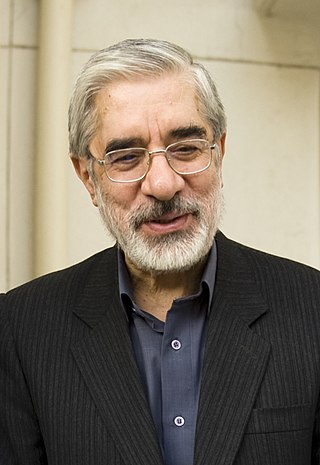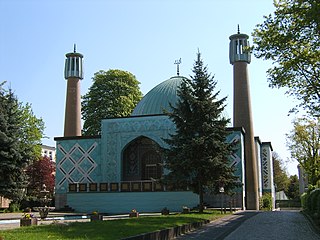
Tehran province is one of the 31 provinces of Iran. It covers an area of 18,814 square kilometres (7,264 sq mi) and is located to the north of the central plateau of Iran.

The Iranian Revolution, also known as the Islamic Revolution, was a series of events that culminated in the overthrow of the Pahlavi dynasty in 1979. The revolution also led to the replacement of the Imperial State of Iran by the present-day Islamic Republic of Iran, as the monarchical government of Mohammad Reza Pahlavi was superseded by the theocratic government of Ayatollah Ruhollah Khomeini, a religious cleric who had headed one of the rebel factions. The ousting of Pahlavi, the last Shah of Iran, formally marked the end of Iran's historical monarchy.

Grand Ayatollah Hussein-Ali Montazeri was an Iranian Shia Islamic theologian, Islamic democracy advocate, writer and human rights activist. He was one of the leaders of the Iranian Revolution and one of the highest-ranking authorities in Shīʿite Islam. He was once the designated successor to the revolution's Supreme Leader, Ayatollah Khomeini, but they had a falling-out in 1989 over government policies that Montazeri claimed infringed on people's freedom and denied them their rights, especially after the 1988 mass execution of political prisoners. Montazeri spent his later years in Qom and remained politically influential in Iran, but was placed in house arrest in 1997 for questioning "the unaccountable rule exercised by the supreme leader", Ali Khamenei, who succeeded Khomeini in his stead. He was known as the most knowledgeable senior Islamic scholar in Iran and a grand marja of Shia Islam. Ayatollah Montazeri was said to be one of Khamenei's teachers.

Qazvin ProvinceIPA:[ɢæzˈviːn] is one of the 31 provinces of Iran. It is in the northwest of the country, with the city of Qazvin as its capital. The province was carved out of Tehran province in 1993. At the time of the National Census of 2006, the population of the province was 1,127,734 in 294,305 households. The following census in 2011 counted 1,201,565 inhabitants living in 352,472 households, of whom 68.05% lived in cities and 31.95% in villages. By the time of the most recent census in 2016, the population had risen to 1,273,761 people in 397,165 households.

Mehdi Karroubi is an Iranian Shia cleric and reformist politician leading the National Trust Party. Following 2009–2010 Iranian election protests, Karroubi was put under house arrest in February 2011 – reportedly ordered by the Supreme Leader of Iran – without officially being charged, although he is accused of being a "seditionist" and "traitor". As of 2021, he is still confined to his house.

Mir-Hossein Mousavi Khameneh is an Iranian reformist politician, artist and architect who served as the 49th and last Prime Minister of Iran from 1981 to 1989. He was a reformist candidate for the 2009 presidential election and eventually the leader of the opposition in the post-election unrest. Mousavi served as the president of the Iranian Academy of Arts until 2009, when conservative authorities removed him. Although Mousavi had always considered himself a reformist and believed in promoting change within the 1979 Revolution constitution, on 3 Feb 2023, in response to the violent suppression of Iranians by Ali Khamenei, the Supreme Leader of Iran, he announced opposition to the Islamic Republic constitution and asked for a widespread referendum to fully change the constitution and make a fundamental change in Iran's political system.

Qazvin is a city in the Central District of Qazvin County, Qazvin province, Iran, serving as capital of the province, the county, and the district. It is the largest city in Qazvin province.

The Islamic Centre Hamburg is one of the oldest mosques in Germany and Europe and is abbreviated IZH. Established in Hamburg, in northern Germany, in the late 1950s by a group of Iranian emigrants and business people.

Azadi Square, formerly known as Shahyad Square, is a mainly green city square in Tehran, Iran. It hosts as its centerpiece the Azadi Tower. The tower and square were commissioned by Mohammad Reza Pahlavi, the last Shah of Iran, to mark the 2,500th year of the foundation of the Imperial State of Iran.

The Grand Bazaar is an old historical bazaar in Tehran, Iran. It is split into several corridors over 10 kilometres (6.2 mi) in length, each specializing in different types of goods, and has several entrances, with Sabze-Meydan being the main entrance.

Valiasr Street, formerly known as the Pahlavi Street, is a tree-lined street in Tehran, dividing the metropolis into western and eastern parts which were built in 1922 to 1927 respectively, considering the end of asphalt plan it ended in 1933. It is considered one of Tehran's main thoroughfares and commercial centers. It is also the longest street in the Middle East, and was reported as one of the longest in the world by former BBC journalist Rageh Omaar during the television documentary Welcome to Tehran.

Damghan is a city in the Central District of Damghan County, Semnan province, Iran, serving as capital of both the county and the district.
Shabestar is a city in the Central District of Shabestar County, East Azerbaijan province, Iran, and serves as capital of both the county and the district.

A Husayniyya is a congregation hall for Twelver Shia Muslim commemoration ceremonies, especially those associated with the Mourning of Muharram. Hussainiya is a multitude hall for the mourning of Muharram and other commemoration rituals of Shia that its name gets from Husayn ibn Ali, the grandson of Muhammad.

Sayyid Mahmoud Alaei Taleghani was an Iranian theologian, Muslim reformer, democracy advocate and a senior Shi'a Islamic Scholar and thinker of Iran. and a leader in his own right of the movement against Shah Mohammad Reza Pahlavi. A founding member of the Freedom Movement of Iran, he has been described as a representative of the tendency of many "Shia clerics to blend Shia with Marxist ideals in order to compete with leftist movements for youthful supporters" during the 1960s and 1970s. His "greatest influence" has been said to have been in "his teaching of Quranic exegesis," as many later revolutionaries were his students.
Following the 2009 Iranian presidential election, protests against alleged electoral fraud and in support of opposition candidates Mir-Hossein Mousavi and Mehdi Karroubi occurred in Tehran and other major cities in Iran and around the world starting after the disputed presidential election on 2009 June 12 and continued even after the inauguration of Mahmoud Ahmedinejad as President of Iran on 5 August 2009. This is a timeline of the events which occurred during those protests.

The Ashura protests were a series of protests which occurred on 27 December 2009 in Iran against the outcome of the June 2009 Iranian presidential election, which demonstrators claim was rigged. The demonstrations were part of the 2009 Iranian election protests and were the largest since June. In December 2009, the protests saw an escalation in violence.

On 30 December 2009, pro-government rallies, also known as the "Dey 9 epic", took place in various Iranian cities, including Tehran, Shiraz, Arak, Qom and Isfahan. The rallies were hold in response to the Ashura protests, where protesters on that day did acts including "applauding, whistling, and engaging in other cheerful displays," which was viewed as violation of a "red line" and targeting Husayn ibn Ali and Ashura commemoration itself. The demonstrations and counter-demonstrations were connected to the disputed 2009 Iranian presidential election.

The Shah Mosque, also known as the Soltāni Mosque meaning "royal", renamed the Imam Mosque, after the 1979 Iranian Revolution, is a principal mosque in the northern section of the Grand Bazaar in Tehran, Iran.

The Sepahsālār Mosque is a famous historic mosque in Tehran, Iran. The construction project of the mosque was started in 1879 upon the order of Mirza Hosein Sepahsalar, the Grand Vizir of Iran during Naser al-Din Shah Qajar, and the first phase of construction was finished after five years since it was started. The mosque was renamed the Shahid Motahhari, after the 1979 Iranian Revolution, but it is commonly known as its initial name of Sepahsalar Mosque.

































